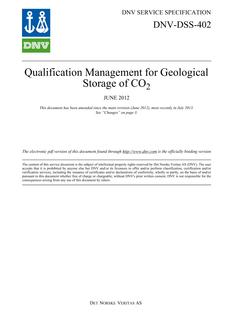-
-
Available Formats
- Availability
- Priced From ( in USD )
-
Available Formats
-
- Secure PDF 🔒
- Immediate download
- $57.00
- Add to Cart
-
- Printed Edition
- Ships in 1-2 business days
- $57.00
- Add to Cart
Customers Who Bought This Also Bought
-

DNV DNV-DSS-402
Priced From $57.00 -

DNV DNV-RU-SHIPS PART 6 CHAPTER 30
Priced From $57.00 -

DNV DNV‐RU‐NAVEL PART 5 CHAPTER 3
Priced From $57.00
About This Item
Full Description
Scope and application
This RP provides the design philosophy, loads and global analysis aspects valid for risers made of composite materials. The RP applies to all new built riser systems and may be applied to modification, operation and upgrading of existing risers.
The risers covered in the RP can be jointed or continuous. Bonded rubber risers and risers with un-bonded load bearing structures are not included. Applications are production, drilling and injection risers, as well as choke and kill lines.
Composites are fibre reinforced plastics. The fibres should have a higher modulus than the surrounding polymeric matrix material. The matrix may be thermoset or thermoplastic.
Composite risers have typically internal and external liners around the main pipe section. Any material may be chose for the liners, as long as long term performance of the liners can be demonstrated. Standards related to chosen liner material shall be used to document liner performance. Additional requirements to liners and interfaces are given in Sec.6.
Composite risers have typically metal end flanges. Any material may be chosen for the flanges, as long as long term performance of the flanges can be demonstrated. Standards related to chosen flange material shall be used to document performance of the flanges. Additional requirements to end flanges are given in Sec.6 (composite metal interface).
The scope covers design, materials, fabrication, testing, operation, maintenance and re-assessment of riser systems. Aspects relating to documentation, verification and quality control are also addressed. The main purpose is to cover design and analysis of top tensioned and compliant composite riser systems operated from floaters and fixed platforms. The RP applies for permanent operation (e.g. production and export/ import of hydrocarbons and injection of fluids), as well as for temporary operation (e.g. drilling and completion/ workover activities).
This RP is applicable to structural design of all pressure containing components that comprise the riser system. Other composite components can be designed according to DNVOS- C501.
Guidance note:
Most composite risers of today consist of metallic or polymeric liners within the composite pipes. The purpose of the liners is to prevent leakage of the riser, while the composite pipes are the load carrying part of the riser system. This RP covers risers with (and without) liners as well as riser connectors and other riser components such as tension joints and stress joints.
There are, in principle, no limitations regarding floater type, water depth, riser application and configuration. However, for novel applications where experience is limited, special attention shall be given to identify possible new failure mechanisms, validity/adequacy of analysis methodology and new loads and load combinations.
Guidance note:
Composite risers are novel applications and it shall be documented that the global load effects can be predicted with same precision as for conventional riser systems. This may typically involve validation of computational methodology by physical testing.
As an alternative, an appropriate conservatism in design should be documented.
Procedures of DNV-RP-A203 "Qualification of new technology" should be considered




